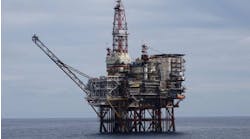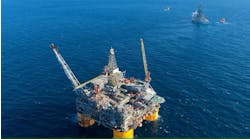Last year, crude oil was above $25/bbl, natural gas was in the $3.00/Mcf range, and skepticism abounded that such utopia could continue. Who would have believed that in the following six months natural gas prices would double and even triple by year end? This past month, gas prices loomed in the $5.00/Mcf range, and there is talk of shortages.
Seminal events occurred on both the supply and demand sides of the equation that derailed the US gas industry's first steps on the widely-touted 30 tcf journey. Price spikes have been a public relations nightmare. On the supply side, the crude oil price collapse was the trigger that set into motion a series of fateful events. In January 1998, domestic crude oil broke below the $15/bbl psychological floor before bottoming at a record low under $10/bbl in December. Prices did not recover to the $15/bbl level until April 1999. Even though crude oil prices were starting to recover in early 1999, the rig count continued declining before finally reversing in April. There was disbelief that a turnaround had occurred.
Throughout the depths of this depression, drilling shifted to less risky, yet less bountiful prospects. During 1998 and 1999, reserve additions fell by about one-third to 0.8 bcf per well, from 1.2 bcf per well during more "normal" years - 1997 and 2000. What contributions were made did not pull their full weight historically. Meanwhile, overall dry holes remained in the 20% range throughout the period. A single ray of hope was an increase in the exploratory success rate in 1999, to 46% from approximately 33%. By 2000, total onshore reserve additions had nearly returned to 1997 levels. Meanwhile, annual demand had grown 711 bcf higher.
During this time, the market sent a false price signal to producers. Starting in August 1998, wellhead natural gas prices weakened, implying that demand might also be weakening. Inter-fuel competition from petroleum products maintained downward competitive pressures. It was not until May 1999 that gas prices began giving any upward price signal.
Demand growth
Compounding this was confusion arising from demand statistics. At the end of 1998, Energy Information Agency statistics indicated that gas demand had fallen by 708 bcf annually from 1997 levels. At the end of 1999, this earlier figure was again adjusted downward by an additional 104 bcf, further adding to the perception that the market was contracting.
However, initial calendar year 1999 statistics indicated that there had been a possible modest recovery of 249 bcf. At the end of year 2000, the 1999 statistics had been further revised to show an additional 192 bcf of demand. At the end of calendar year 2000, statistics indicated that year 2000 demand had grown by a further 980 bcf over the revised 1999 level.
What caused demand growth to sneak up on supply? The answer is simple: a surge in electricity generation. A low hydro-generation situation that caused an additional 1 bcf/d of gas demand aggravated conditions.
New merchant generating plants are having a dramatic impact on gas demand. Between 2000 and 2003, incremental gas consumption caused by new plants will require 400-500 bcf annually, a rate of 1.2-1.4 bcf/d). The cumulative impact totals 1.9 tcf by 2003. Should all "announced" facilities be built, these numbers would double.
In recent years, soaring summer power generation has created a disproportionate growth in summer gas demand with an emerging mini-peak. Summer demand has grown in August to 52-54 bcf/d. By 2002, however, the summer demand peak will expand to over 58 bcf/d. If the trend persists, summer's peak will approach the winter peak at the 60+ bcf/d level. Thus, possibly during or after 2002, the industry could see scattered storage withdrawals in the summer for the first time.
The classic example of the shortfall has been the California power crisis. California is now reactivating mothballed oil generating facilities, and in essence will trade power for pollution. This is a short-term solution that will generate electricity but won't back out appreciable gas.
During the first quarter of 2001, there has been a rash of construction announcements for coal-fired power plants, the first of which should start showing up in 2003. Longer-term, this should begin to alleviate some of the pressure on gas for electricity generation.
Capacity problem
The heart of today's publicized energy crisis is actually a capacity problem - the ability to generate enough electricity and the short-term availability of the chief raw material, natural gas. Thus, gas is positioned to receive double blame for shortfalls in electricity production.
Gas deliverability has been tightening from an annual "cushion" of 6% in 1997, to 3% in 1998, 2% in 1999, and finally to 1% by 2000 (negligible spare capacity). Already slim deliverability margins were shrinking at the very time drilling was being curtailed. During the calendar year 1998, lower-48 gas deliverability fell by 526 bcf.
In 1980, deliverability approached 72 bcf/d, implying an E&P industry capability to support a 26 tcf annual gas market (assuming no spare capacity, like today). Such deliverability amounted to a "cushion" of 30%, relative to actual production. By the depths of the 1980s market collapse, the cushion had expanded to 40%. Today, deliverability has not recovered from 1998-1999, although drilling levels are setting new records.
Where next?
Some of the factors that caused this condition will relieve the pressure over the longer term. In the near-term, an economic slowdown will allow some loosening in supply. The potential for a textbook recession is increasing during 2001. However, a recession-induced decline in industrial gas demand of about 3 bcf/d would be largely offset by the growing appetite for electric generation.
The only factor moderating demand growth for power generation is today's relatively high prices. The demand impact of a mild recession would be to drop yearly average 2001 levels back to about 62 bcf/d (1999 levels). This represents a 2 bcf/d drop from 2000. However, annual demand should regain strength by 2002 surpassing 66 bcf/d.
Increased lower-48 gas production dominates growth in US gas supply. Just after 2003, lower-48 gas production (not demand) will exceed its 1973 peak of 21.7 tcf.
Short term, the question is where production will originate to ensure adequate supply growth. The GTI Baseline Projection indicates that between 2000 and 2005, the five top supply regions will contribute nearly 3.5 tcf as follows:
- Gulf of Mexico - 1.97 tcf
- Rockies and Mid-Continent - 430 bcf each
- Arkla-East Texas- 362 bcf
- Appalachia - 302 bcf.
A 30 tcf future will require contributions from many supply sources. No single area will be able to meet all the additional requirements.
Gulf of Mexico
Growing Gulf of Mexico contributions from deepwater (>200 meters) and the ultra-deepwater (>1,000 meters) will build on the established, but declining, production of the shelf. The Gulf will show a string of impressive annual production gains between now and 2005: 1.6 bcf/d by 2002, another 1.3 bcf/d by 2003, and 1 bcf/d into 2004.
The shelf (0-200 meters), with an infusion of money and increased drilling activity, should regain much of the loss incurred in 1998 and 1999 (551 bcf recovery) between now and 2005. However, long-term shelf production will decline to 3.4 tcf annually from today's 3.9 tcf level. By 2020, deepwater and ultra-deepwater will contribute annually 1.1 tcf and 1.5 tcf, respectively.
The planned lease sale 181 in the Eastern Gulf of Mexico is environmentally and politically charged. First production from the area should occur in 2005 at 31 bcf annually and grow to 306 bcf by 2020. Elsewhere, the subsalt will expand gradually from approximately 100 bcf currently to 1.2 tcf annually by 2020.
A recent incentive by the US Minerals Manage-ment Service (MMS) applying to new leases allows operators who drill a successful subsalt well to apply for a two-year lease extension and should expand production from the play. Fortunately for 2001 gas markets, E&P management had the wisdom to continue long-lead deepwater projects during the 1998-1999 decline, ensuring near-term supply today.
Canada
Projected Canadian supply growth illustrates increased contributions from provinces outside Alberta. Alberta production remains relatively flat after 2007. Between now and 2020, production from British Columbia and the Eastern Provinces increases by almost 3 tcf. For Canada, production growth will total 1.2 tcf (3 bcf/d) with the following contributions:
- Alberta - 822 bcf
- British Columbia - 262 bcf
- Eastern Canada - 74 bcf.
The volumes needed to fill the import pipelines will represent a significant increase in Canadian production. Production will expand by 5.5 tcf over the projection period to a level approaching 11.7 tcf by 2020.
One bullish wild card in the Canadian supply picture is the presence of large frontier areas with excellent potential, particularly Mackenzie Delta and Eastern offshore basins. Production from Mackenzie Delta is anticipated to begin in 2012. Once developed, these frontier areas have the potential to dramatically increase supply, possibly resulting in overall Canadian production surprises beyond levels suggested here.
Pipeline imports, LNG
Pipeline imports offer only minimal relief in the short-term due to tight deliverability conditions in Canada. Growth in pipeline imports will be strongest from 2001 until 2005, increasing to the 4 tcf level. Afterwards, growth is expected to be more gradual, averaging 3.4% annually out to 2020.
One of the reasons Canadian pipeline imports will ease near-term is a similar decline in deliverability potential. Although the condition is better than in the US, there has been a definite tightening in recent years. As in the US, increased drilling has not yet restored large reserve or deliverability increases.
Longer term, pipeline imports are projected to grow from 3.4 tcf in 2000 to 8 tcf by 2020. By way of comparison, pipeline imports accounted for about 15% of total US gas supply in 2000. By 2020, imports are projected to provide for almost 23% of total US gas supply.
The recent tight gas market has improved the prospects for increased LNG imports. On an annual basis, LNG contributions are relatively small (1% range). But on a shorter time horizon, such as a daily basis, this can amount to several hundred MMcf/d, which helps ameliorate demand peaks.
Such supplemental supplies are projected to increase from the current level of about 100 bcf annually to 400 bcf by 2005 and to 800 bcf by 2020. This increase reflects a greater capacity usage of the four existing domestic LNG import facilities and assumes that two mothballed facilities are allowed to reopen. However, neighbor objections already threaten the Cove Point re-opening.
The energy crisis in California has raised the prospect for a LNG import facility on the West Coast. Environmental hurdles in California, which thwarted much-needed power plants, could inhibit LNG construction. A possible alternative would be a grassroots facility strategically situated in northern Mexico. To the extent and time-frame a new import facility could be added, LNG imports would serve to alleviate the Pacific Coast supply-demand balance, especially during peak seasonal periods.
Mexico's Burgos
The natural gas potential in the Burgos Basin of Northeastern Mexico may be significantly greater than previously thought. GTI estimates that Burgos could contain a total undeveloped resource of 21-75 tcf, or roughly 3-10 times current proven recovery. The Burgos Basin is an extension of the Texas Gulf Coast province with very similar geology, producing formations, and expected ultimate yield.
In recent years, Burgos gas production has increased more than four-fold to more than 970 MMcf/d. Through 1999, Pemex was very successful in increasing production from the basin, and appears on track in achieving stated production goals. Burgos gas production is projected to continue increasing, reaching a level of 2.3 bcf/d by 2015. However, due to demand growth in Mexico, GTI projects that Mexico will continue to be a net importer of gas with net imports peaking near 270 MMcf/d by 2005.
There is a distinct possibility that the US will not be able to supply this level of export because incremental supplies would need to originate in the Rockies. However, investment levels allowing 50 wells annually above current Pemex Burgos plans could easily tip the balance in the opposite direction and enable Mexico to instead export gas to the US.
This analysis explored the factors, pressures, and chain of events, which caused the current quandary. Findings indicate that similar factors will work in the short and long-term, to eventually restore order, including:
- An economic slowdown in 2001 will give gas E&P a second chance to catch up.
- A demand surge looms in 2002 with an associated price spike.
- By 2002, the growing summer peak could see scattered storage withdrawals occurring in August.
- There is little hope for significant consumer price relief prior to 2004.
- No single supply region or gas source will be the "silver bullet" solution to tight gas supply.
Recent events spotlight the interdependency between gas and electricity markets and the need for a coordinated energy strategy among the US, Canada, and Mexico if natural gas is to achieve full potential as a reliable supply source.


